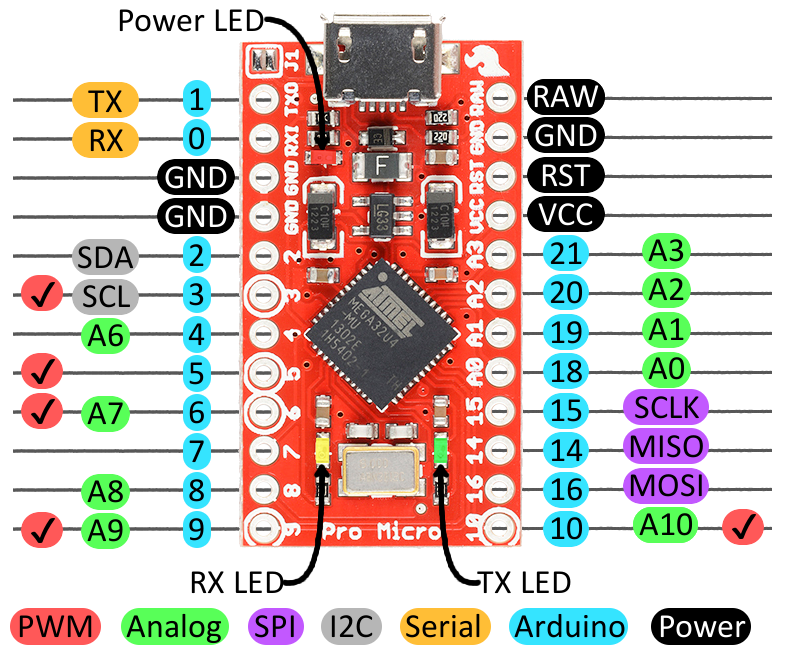Boards, Shields, and Keymaps
Architecture Overview
The foundational elements needed to get a specific keyboard working with ZMK can be broken down into:
- A KSCAN driver, which uses
compatible="zmk,kscan-gpio-matrix"for GPIO matrix based keyboards, or usescompatible="zmk,kscan-gpio-direct"for small direct wires. - An optional matrix transform, which defines how the KSCAN row/column events are translated into logical "key positions". This is required for non-rectangular keyboards/matrices, where the key positions don't naturally follow the row/columns from the GPIO matrix.
- A keymap, which binds each key position to a behavior, e.g. key press, mod-tap, momentary layer, in a set of layers.
These three core architectural elements are defined per-keyboard, and where they are defined depends on the specifics of how that keyboard works. For an overview on the general concepts of boards and shields, please see the FAQs on boards and shields.
Self-Contained Keyboard
For a self-contained keyboard that includes the microprocessor, all of the above architecture components are included in the Zephyr board definition. You can see an example for the Planck V6 board directory.
With this type of keyboard, the full ZMK definition for the keyboard exists
in the app/boards/${arch}/${board_name} directory, e.g. app/boards/arm/planck/. In that directory, you'll have the following:
- A
Kconfig.boardfile that defines the toplevel Kconfig item for the board, including which SoC Kconfig setting it depends on. - A
Kconfig.defconfigfile that sets some initial defaults when building this keyboard. This usually includes:- Setting
ZMK_KEYBOARD_NAMEto a value, for the product name to be used for USB/BLE info. - Setting
ZMK_USBand/orZMK_BLEfor the default values for which HID transport(s) to enable by default
- Setting
- A
${board_name}_defconfigfile that forces specific Kconfig settings that are specific to this hardware configuration. Mostly this is SoC settings around the specific hardware configuration. ${board_name}.dtswhich contains all the devicetree definitions, including:- An
#includeline that pulls in the specific microprocessor that is used, e.g.#include <st/f3/stm32f303Xc.dtsi>. - A chosen node named
zmk,kscanwhich references the configured KSCAN driver (usually a GPIO matrix) - (Optional) A chosen node named
zmk,matrix_transformthat defines the mapping from KSCAN row/column values to the logical key position for the keyboard.
- An
- A
board.cmakefile with CMake directives for how to flash to the device. - A
keymap/keymap.overlayfile that includes the default keymap for that keyboard. Users will be able to override this keymap in their user configs.
Pro Micro Compatible Keyboard

For keyboards that require a (usually Pro Micro compatible) add-on board to operate, the ZMK integration pieces are places in the shield definition for that keyboard, allowing users to swap in different Pro Micro compatible boards (e.g. Proton-C, or nice!nano) and build a firmware the matches their actual combination of physical components.
With this type of keyboard, the partial definition for the keyboard exists
in the app/boards/shields/${board_name} directory, e.g. app/boards/shields/clueboard_california/. In that directory, you'll have the following:
- A
Kconfig.shieldthat defines the toplevel Kconfig value for the shield, which uses a supplied utility to function to default the value based on the shield list, e.g.def_bool $(shields_list_contains,clueboard_california). - A
Kconfig.defconfigfile to set default values for things likeZMK_KEYBOARD_NAME - A
${shield_name}.overlayfile, which is a devicetree overlay file, that includes:- A chosen node named
zmk,kscanwhich references the configured KSCAN driver (usually a GPIO matrix). For these keyboards, to be compatible with any Pro Micro compatible boards, the KSCAN configuration should reference the nexus node that ZMK has standardized on. In particular, the&pro_microaliases can be used to reference the standard digital pins of a Pro Micro for shields. - (Optional) A chosen node named
zmk,matrix_transformthat defines the mapping from KSCAN row/column values to the logical key position for the keyboard.
- A chosen node named
- A
keymap/keymap.overlayfile that includes the default keymap for that keyboard. Users will be able to override this keymap in their user configs.